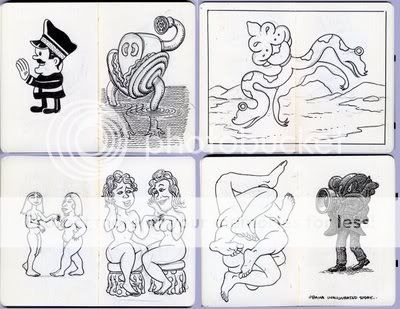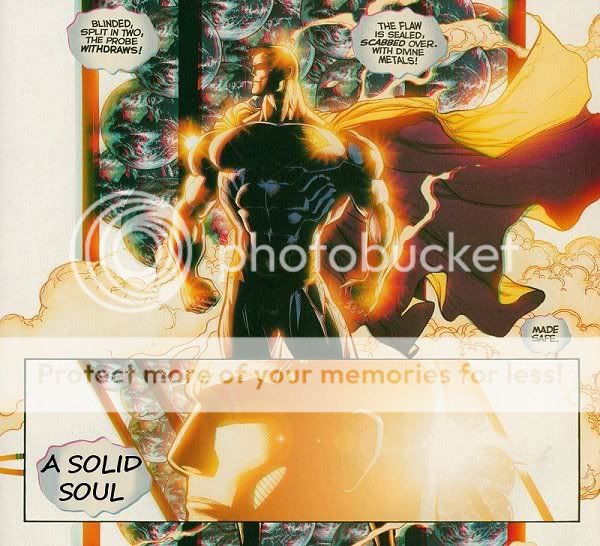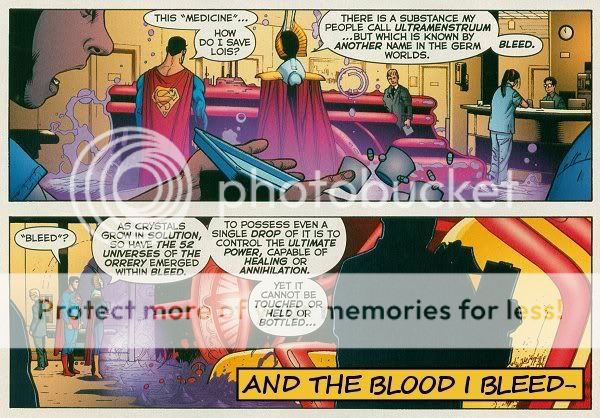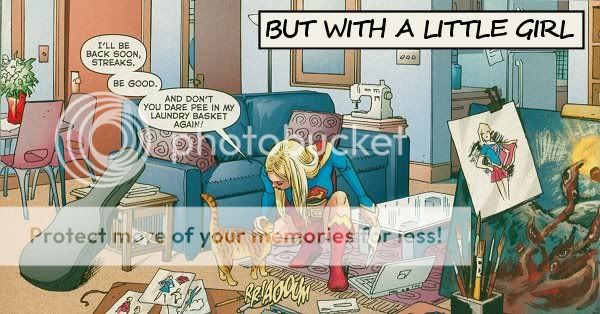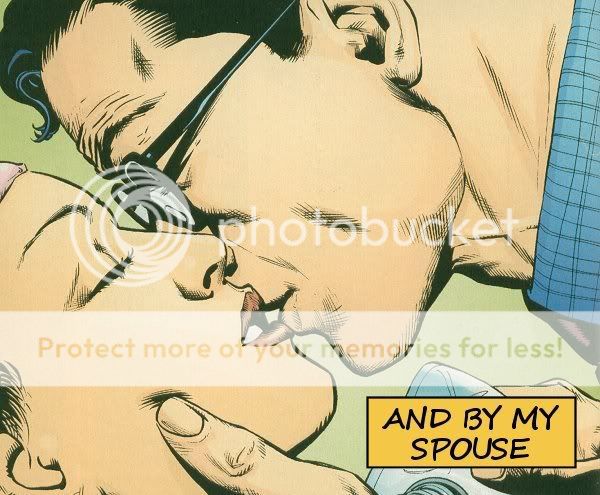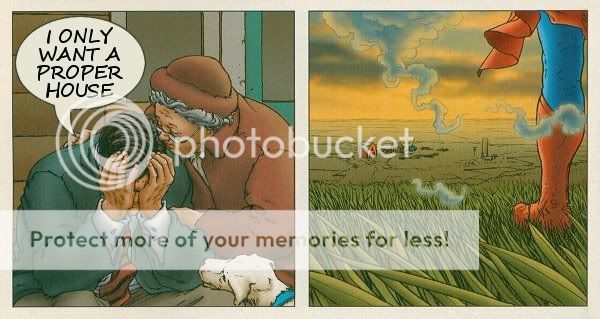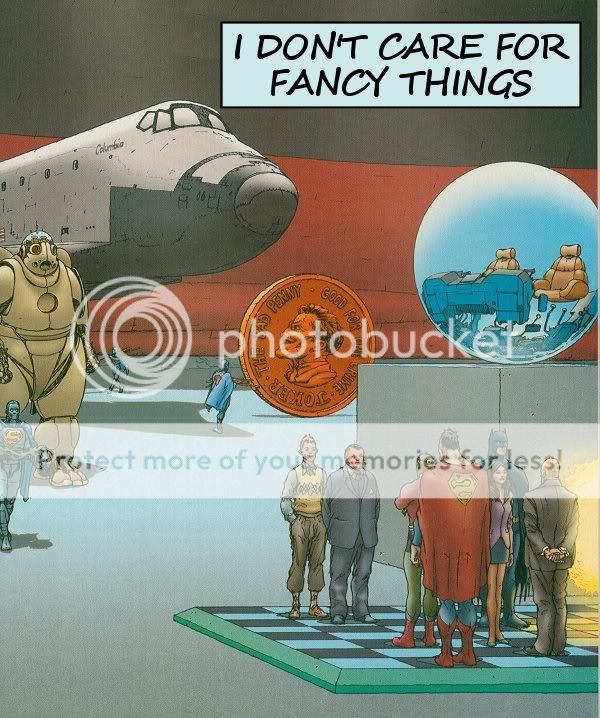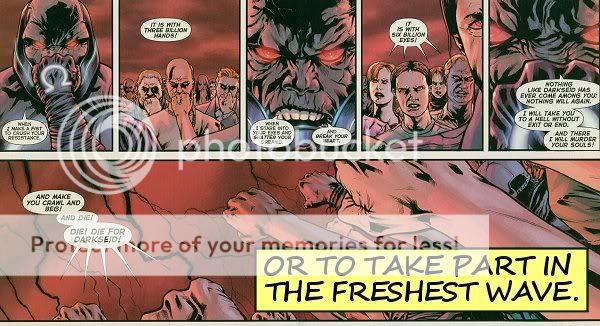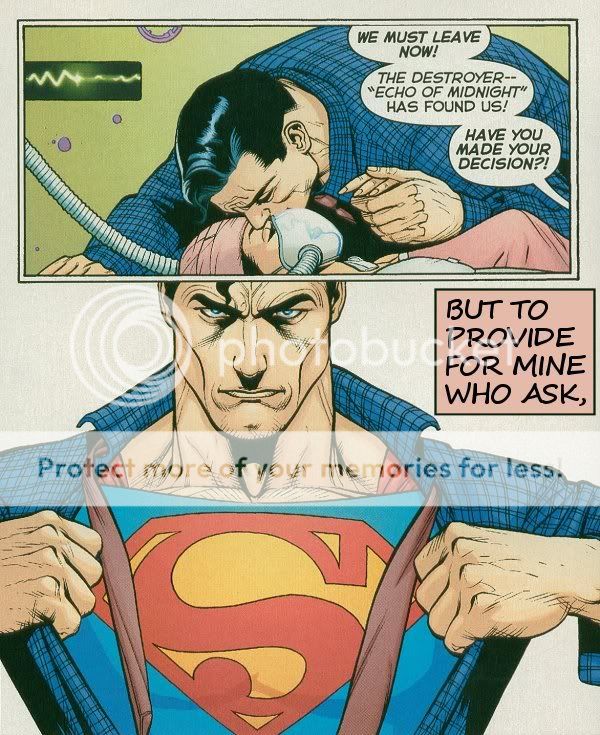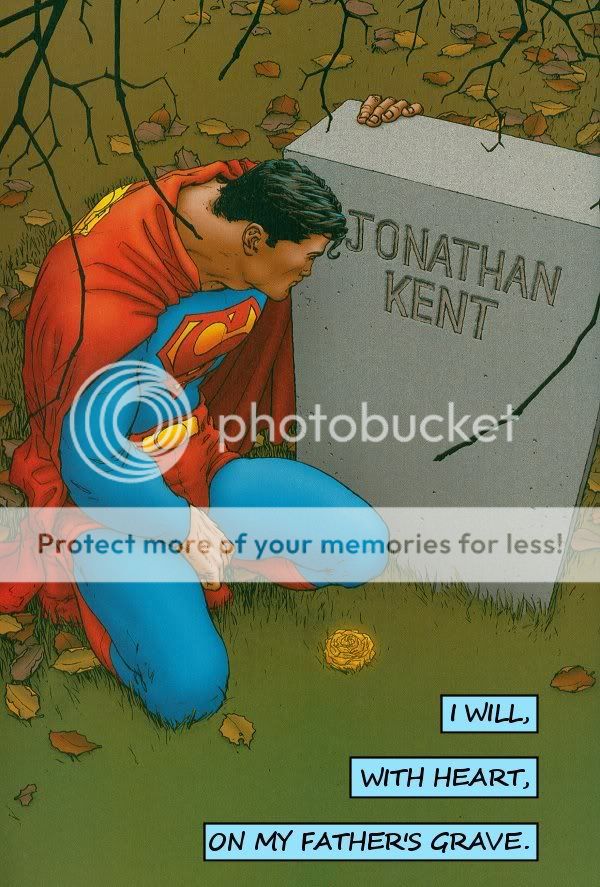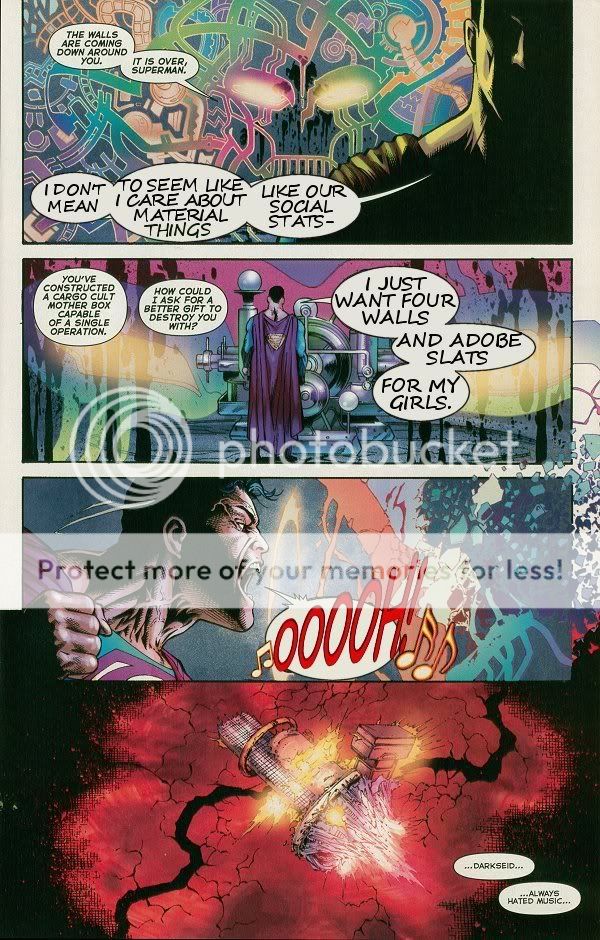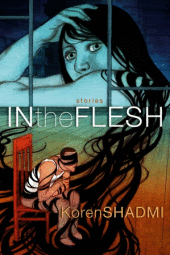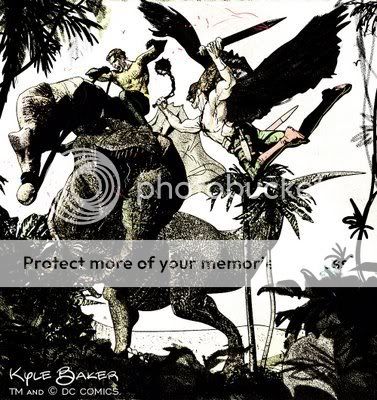Archive for February 6, 2009
Comics Time: McSweeney’s Quarterly Concern #13
February 6, 2009McSweeney’s Quarterly Concern #13
Dave Eggers, series editor
Chris Ware, guest editor
Chris Ware, Gary Panter, E.D. Muenchow, Ivan Brunetti, Charles Burns, David Heatley, Seth, R. Crumb, Daniel Clowes, Rodolphe Topffer, John McClenan, Bud Fisher, Milt Gross, Louis Beidermann, Kaz, Mark Newgarden, Jim Woodring, Archer Prewitt, Lynda Barry, Charles Schulz, George Herriman, Philip Guston, Mark Beyer, Richard Sala, Art Spiegelman, Kim Deitch, Joe Sacco, David Collier, Chester Brown, Ben Katchor, Richard McGuire, Jeffrey Brown, Julie Doucet, Joe Matt, Gilbert Hernandez, Jaime Hernandez, Adrian Tomine, David Heatley, Ron Rege Jr., John Porcellino, writers/artists
Ira Glass, Chris Ware, John Updike, Charles M. Schwab, F.W. Seward Jr., Tim Samuelson, Glen David Gold, Michael Chabon, Chip Kidd, writers
McSweeney’s Quarterly, 2004
The other day I said that most of the big hardcover comics anthologies put out by prose publishers over the past few years draw from a “comics as high art” canon consisting of classic newspaper strips, the undergrounds, RAW, people who were published by Fantagraphics or Drawn & Quarterly during the ’90s, and Kramers Ergot. Turns out I really nailed it when it comes to McSweeney’s #13: I could be wrong, and correct me if I am, but after taking a closer look at this one I’m pretty sure that every single cartoonist in the book falls into one of those categories. What’s more, it pares away the wilder edges: The only underground guys you’ll find here are the three most high-falutin’, R. Crumb, Kim Deitch, and Art Spiegelman; the Kramers contributors–the ones that aren’t covered in any of the other categories, that is–are lo-fi autobio guys like Jeffrey Brown and David Heatley, while (depending how you count one of Ron Rege’s most straightforward and topical comics ever) the whole Providence school of noisecomix is nowhere to be found.
In other words, editor Chris Ware is presenting a very, very specific, and familiar, vision of alternative/art/literary comics here. There’s the emphasis on artifact and ephemera, with reproductions of a hand colored copy of a Rodolphe Topffer bootleg and bizarre old-timey “comics are good for the sould” advertorials, while sketches or unfinished strips from George Herriman and Charles Schulz presented as their contributions to the book. There’s the prominent masturbation humor placed toward the beginning and end of the book so you really can’t miss it. There’s the de rigeur current-events strip or three. There’s the ever-present link to mortifying memories of lonely childhoods in which superhero comics serve as both instigator and mitigator of misery–witness basically all the guest text pieces, particularly those of Chip Kidd and Glen David Gold. There’s the plethora of strips about how loveless and thankless and pointless is the life of the artist/thinking man/aesthete in general and the cartoonist in particular. When certain critics trot out their anti-altcomix hobbyhorses, this book is almost certainly the sort of thing that makes them whip those suckers into a gallop.
There are plenty of reasons not to give a damn about that, mind you. Ware, of course, is a genius, and his taste is as respectable and enjoyable as you’d imagine, if a bit narrow. He has a terrific eye for excerpts: the surreal ending of the otherwise realistic passage from Black Hole he includes must be absolutely stunning to people who’ve never seen it in context, for example, while the chapter he takes from Louis Riel, featuring the execution of a loudmouthed Anglo prisoner, would most likely close out Chester Brown’s highlight reel. In both cases a particular skill of the artist is emphasized: With Charles Burns, it’s how his inks can subtly shift between sensualism and horror; with Brown, it’s his knack for staging, in this case displayed by how the prisoner’s censored rantings take on an almost physical presence that absolutely overwhelms the staid characters at which it is directed. Then there’s the novel way he handles Los Bros Hernandez, intercutting two unrelated stories by Gilbert and Jaime in order to approximate the experience of reading them in their two (and sometimes three) man anthology series. I think Gilbert’s material (the devastating, temporally jumping “Julio’s Day”) comes off the stronger, but that of course is also one of the pleasures of reading Los Bros.
And that’s not all. While not quite the knockout blows listed above, the material from artists like Joe Sacco, Adrian Tomine, Dan Clowes, and Ware himself are also quite strong. Unexpected contributions from John Updike and Philip Guston are roped in. The early section on newspaper strips cleverly arranges contributions from Mark Newgarden, Ivan Brunetti, Clowes, Ware, Crumb, Seth, Kaz and more right up against Mutt and Jeff and the like, making an implicit argument that the strip format holds as much potential as the more traditional graphic-novel or short-story modes. Meanwhile, it’s always edifying to read Gary Panter or Mark Beyer, and one of the great comforts of all these big anthologies is that I know I’m never more than 100 or so pages away from some Ben Katchor. Entertainingly, the packaging, as it were, may be the best and most innovative part of the book. Strong minicomics by Ron Rege Jr. and John Porcellino are tucked into the folds of a massive, and massively impressive, cover by Ware. The competing takes on “the history of comics” presented on the front of the cover by Ware, the inside of the cover by Panter, and the endpapers by Brunetti are dazzling, while reproducing images from a 1936 “How to Cartoon” guide by E.D. Muenchow was inspired.
Now, there are the same old problems any anthology has, too. This is likely just a YMMV issue, but the predilection of many anthologizers to place material from Seth and Joe Matt back-to-back merely reminds me that I’ve never much cared for either; Matt’s subject matter is usually dull and offensive, while for some reason I’ve just never felt comfortable with how Seth’s thick, wavy lines sit on the page. I’ve yet to be sold on Lynda Barry or Richard Sala either. And not all of Ware’s selections are as perfect as the ones listed above: Richard McGuire’s “ctrl” is lovely to look at, but he handled the subject matter with tons more nuance and sensitivity in “Home”; and just once I’d like to see Ivan Brunetti represented by stuff from Haw! And as far as Ware’s editorial presence is concerned, he sometimes lets his enthusiasm get the better of him, as you can see in his text pieces, which are heavy on hyperbolic assertion: “Charlie Brown was a real personality, living on the newspaper page—he wasn’t a picture of someone, he was the thing itself…”; “Philip Guston is the first painter, ever, to truly paint a portrait from the inside out.” If he was a blogger writing about Final Crisis, other bloggers would be writing about how ridiculous he sounds.
But those last few concerns are all pretty minor in the face of a book full of, let’s face it, really good comics by really good creators. I mean, there are only four contributors I don’t care for or something like that, right? What’s to complain about? Well, it’s a lack of imagination, that’s what. And I’m as surprised as anyone to here me say that about an effort from Chris freaking Ware. But while there are standout moments to be found here—the cleverly constructed cover materials, the creative editorial layouts of the strip material and the Hernandez Brothers’ stuff, the Burns and Brown selection—the primary sensation engendered by reading McSweeney’s #13 is “yep, that’s exactly what I expected.” And that’s a real bummer in a way, isn’t it? Leading with a bunch of strips about how dull and pathetic it is to be an artist, then segueing into a Crumb strip called “The Unbearable Tediousness of Being” just to hammer the point home; sprinkling it with guest appearances from prominent prose writers who can’t shake the melancholy of their six-year-old selves dressing up in towels and underwear and pretending to be Batman; closing with a Brunetti strip about how Kierkegaard intentionally sabotaged his own love life, then died alone, segueing into those adorable “history of cartooning” endpages also by Brunetti, so that what you’ve just read in the Kierkegaard strip calls into question any pleasure you might get from Brunetti’s laser-precision pastiches of Superman, Eustace Tilly, Mr. Peanut, Enid Coleslaw, Fred Flinstone et al…I dunno, is this what comics is? Obviously it is to Ware, and the chances are good it is to a decent chunk of the McSweeney’s audience, so maybe this is exactly what they wanted to see. It’s just not what I wanted to see, and probably not what I would have chosen to show, either.
Carnival of souls
February 5, 2009* Today I popped up in a couple of interesting places on the Internet. For starters, there’s the new comic by me and Matt Rota that I mentioned earlier, now playing at Top Shelf 2.0.
* Next, I’m the subject of this week’s installment of Show Us Your Shelf Porn over at Robot 6. Feast your eyes, glut your soul. (God, I feel so naked.)
* While I’m busy talking about myself, I just want to remind everyone that I’ll be attending the New York Comic Con tomorrow afternoon and Saturday. You can catch me at the Twisted ToyFare Theater panel on Saturday at 5:30pm in room 1A17. Failing that, you can find me wandering around the floor with such comics-commentary luminaries as Josiah Leighton, Kiel Phegley, Ben Morse, Dave Paggi, TJ Dietsch, Rickey Purdin, Matt Powell and so on. I’m not sure what I’ll be wearing, but you shall know me by the David Bowie Sketchbook. (And my hair is bushy right now, unless I shave it overnight, which, who knows.)
* Speaking of Kiel Phegley, he’s launched a new interview and news blog called Four Color Forum. Here’s his mission statement. Go, read, as the fella says.
* The Battlestar Galactica prequel Caprica is going to debut in an uncut/unrated DVD release on April 21 prior to its airing on TV. Weird, but nice, but also just a way to get you to buy it twice.
* Tom Spurgeon sings into the Miracle Machine and blasts the thoughtform of Grant Morrison’s Final Crisis into oblivion. While it comes as no surprise that Tom didn’t care for the book–a story written by a person who believes in the concepts articulated in an interview like this is unlikely to speak to someone who believes those concepts to be “paper thin.” Similarly, it’s always tough for me to get much out of Spurgeon superhero criticism when it’s predicated on the notion that the superheroes in question have “no juice left at all to thrill or inspire or encourage”; I simply don’t see why that’s so, because in my experience it’s not. (That’s not to say I share Morrison’s belief in their near-messianic power and appeal; on the contrary, they’re just devices, like zombies or gangsters or egomaniacal doctors or sexy librarians or whatever. It’s all in the execution.) But Tom’s more specific lines of attack are very interesting: unpacking the differences between the use of jump cuts in Final Crisis vs. Jaime Hernandez’s “Tear It Up, Terry Downe,” critiquing the circular logic of Morrison’s notion that Superman and Batman always win because that’s what makes them Superman and Batman, noting the more challenging Jack Kirby conception of Anti-Life, and so on. It’s my favorite negative review of the book to date.
* Morrison himself still has plenty to say about the series and its tie-ins. The IGN interview with Morrison linked above is the longest so far, a rich blend of Morrison expounding upon his ideas and tooting his own horn; among the juicy tidbits is his clearest statement yet that the series was about DC office politics as much as anything else. Meanwhile, Newsarama has posted the second half of its “exit interview,” which is roughly half Morrison yakking in the same vein as the IGN interview and half explaining what happened in the comic to Matt Brady.
* I wasn’t going to link to the non-story about how They want Casino Royale director Martin Campbell to direct a prospective Green Lantern movie, but Rob Bricken at Topless Robot explains in a fun fashion why that idea is interesting even if the “news” angle is bullshit. He also points out that Campbell directed GoldenEye, too, which I did not know. That was a fun movie.
* The Onion AV Club’s Scott Tobias reviews Velvet Goldmine, a movie that dramatically changed my life, as part of his delightful New Cult Canon series. No matter how angry Christian Bale gets, he’ll always be poor, meek Arthur Stewart from the ‘Erald to me.
* There are two great things about Kevin Lee’s review of Paul Verhoeven’s masterpiece Starship Troopers (I don’t know what else to call it–that film is freaking inspired): The part where he points out that part of the fun of the film is that it is not embarrassed of or condescending toward proficiency in straightforward genre/action-movie filmmaking, and the lengthy collection of reviews from contemporary critics who completely missed the fact that the film is a satire. (Via The House Next Door.)
*Paul Pope draws IG-88. That sentence is either completely meaningless to you, or completely awesome.
* I think you’ll agree that seeing Ben Jones art in three dimensions is pretty mind-blowing.
* Dan Nadel blogs about the Mat Brinkman/Melissa Brown art show he curated.
* Finally, the future of comics.
Lost thoughts
February 5, 2009SPOILERS SO BE CAREFUL
1) The main thing I’m taking away from Lost so far this season is the sense that the creators and crew are having a lot of fun just being Lost. Like last week: There was no reason, strictly speaking, to reveal the birth of Desmond and Penelope’s kid in a flashback of undetermined temporal origin, then cut to the present day and show how old the kid is now–it’s just fun for the writers to monkey with flashbacks/flashfowards/time like that, so that’s how they did it. Similarly, in this episode, they just did a bunch of Lost-ish things because it’s fun to do them–having our heroes get shot at by persons unknown, having secondary characters we haven’t seen in a long time pop up out of the blue, riffing on aspects of the show (like the light from the Hatch) that we haven’t thought of in ages, and so on. The show seems to have a lot of confidence in what it is and what it does well at this point. It’s fun to watch.
2) Moreover, there were just a lot of thoughtful, intelligent moments, where they could have played a particular plot point a number of ways but went in just the right direction with it. For example: Of all the moments that the time-displaced castaways could have stumbled upon past or future versions of themselves in the middle of, they have Sawyer come across Kate delivering Claire’s baby. It’s the perfect moment to use: A) Sawyer loves Kate, so it’s heartbreaking to see her; B) Everyone loves the birth of babies, so it’s a hugely emotional moment for Sawyer just for that reason; C) Sawyer’s not the deepest thinker, and making him the first castaway to find a recognizable moment from the past therefore emphasizes just what a mindfuck it is; D) put it all together and you’ve got such a mix of intense and bizarre emotions, exactly what you want for the first time you do this on the show.
3) Related: Locke realizing they’re in the middle of the night that Boone died (they mentioned him by name! Hooray! I love it when the story acknowledges people who in show-time died just a few weeks before, as it really should) and the night he really came to believe that he was on the Island for a reason. That’s a rich moment for Locke to relive.
4) Another smart bit: Having Miles keep his illness on the DL, revealing it only to Daniel, the one character who he thinks might know something about it. Miles’s sarcastic personality might make you think he’d make a big screeching deal about it and freak out, but it seems truer and more interesting to make his sarcasm a sort of cloaking device for a more intense desire to be apart from other people. He wouldn’t want to be the center of attention, ever.
5) Another smart bit: I like the way they’re establishing more of a rapport between Juliet and Sawyer. At the rate Lost takes bad guys, or at least ambiguous guys, and makes them into good guys, the only way the show’s relationships work is if they can convincingly create bonds between the characters that emerge from shared adversity. They’re doing a good job with these two right now. It helps that the actors are good at bringing out their mama-bear and wounded-puppy sides respectively. It’s a little corny, but it’s comforting.
6) Still another smart bit: I loved watching Jin wake up on yet another beach filled with yet another group of survivors of yet another wreck, and realize all over again that he doesn’t speak the language. I suppose they couldn’t have gotten a whole lot more out of having him go through that whole storyline over again beyond the initial No Exit impact of him discovering what’s up, so it’s good that Rousseau and her babydaddy can speak some English, but it was a great moment.
7) Michael Emerson’s line readings get more and more awesome with each passing episode. “He’s my lawyer.” I don’t know if I ever would have come up with a way to say that the way he said it, but the way he said it was so funny and perfect.
8) Kudos to the show for not dragging out certain “deception” elements of the plot–like having Ben come right out and say he’s trying to steal Aaron. But boo to continuing this nonsense where Kate and Jack keep refusing to explain to each other why they’re doing what they’re doing. For chrissakes, it takes 30 seconds to tell someone you care about why you’re behaving a particular way. Take the goddamn time. This week’s installment of Todd VanDerWerrf’s must-read weekly review focuses a lot on that particular point. (Be warned, the review drops some Mad Men and BSG spoilers on you out of the blue, a few sentences into the paragraph about how TV series have to create a sense of false drama.)
9) I still don’t know if Sun’s kid counts as someone they need to get back to the Island because she was pregnant when she left. It doesn’t seem like Ben is approaching it that way. Actually, I’m sort of getting the impression that the kid is dead or missing.
10) Obvs, Miles is Dr. Marvin Candle Jr.
11) I can’t figure out who Charlotte is, though. She’s too young to be Ben’s childhood sweetheart Annie. (I’m pretty sure Penny is Annie, anyway.)
12) Fun to see Rousseau as a fresh-faced youngster with a spring in her step and a song in her heart and a bun in the oven and non-high-waisted trousers on her legs.
13) You know what I wonder about? The Hurley bird.
New Sean T. Comics Day
February 5, 2009Top Shelf 2.0 has posted a new comic written by me and drawn by Matt Rota. It’s called 1998 High Street and it’s part of a series of related comics we’ve been calling the Cage Variations. I hope you enjoy it.
Carnival of souls
February 4, 2009* Grant Morrison has cancelled his appearance at this weekend’s New York Comic Con due to family issues. I hope all is well. Selfishly, I’m bummed that I won’t be able to get him in my Bowie sketchbook (he can draw) and that I won’t be able to discover first-hand whether his first post-Final Crisis con appearance would be more like a victory lap or a walk of shame.
* Speaking of NYCC, Tom Spurgeon lists 10 things he’d do if he were there.
* Chris Butcher argues that by raising their minimum order thresholds for Direct Market comic distribution, Diamond is essentially forcing a paradigm shift away from Direct Market distribution toward exclusively digital or print-on-demand distribution, and that since Diamond and the Direct Market are essentially synonymous, this is an odd move to make. I don’t know enough about how all this stuff works to offer an informed comic, but I will say that I can’t imagine a distribution system that cuts out Crickets and Or Else by necessity is a healthy one in the long term.
* The Onion AV Club speaks with The State’s Thomas Lennon, Kerri Kenney-Silver, and David Wain. It is so, so wonderful to hear them refer to The State as a going concern, then see actual evidence for this.
* Stephen King says Twilight author Stephenie Meyer is a lousy writer. This is not a terribly controversial assertion–The Missus loves Twilight to pieces, and even she says author Stephenie Meyer is a lousy writer–but it’s interesting to hear King articulate it, since I think he’s usually a go along to get along type when it comes to his fellow authors. Case in point: “Jo Rowling is a terrific writer,” from the same article. (Via STYD.)
* Ta-Nehisi Coates reports his initial reaction to the opening Battlestar Galactica miniseries, prompting a lengthy comment thread in which various readers recount their equivalent experiences and offer advice as to how best to proceed from there (here’s mine).
* Naomi Watts says They are indeed still remaking The Birds. (Via Jason Adams.)
* Jim Woodring sketchbook fun!
* I’ll admit having said “Yeah, why don’t they do that?” about several of the entries on this list of 10 Helpful Suggestions for Terminating John Connor. I also wonder if they ever explained why the T-800 has an Austrian accent. (I bet there’s a novel somewhere that does.)
* A blog dedicated solely to pictures of Marilyn Monroe and Kate Winslet may well be the greatest possible blog. Proof:

(Via Sean B. Congratulations, Sean!)
Kryptonian Collective
February 4, 2009Comics Time: In the Flesh: Stories
February 4, 2009In the Flesh: Stories
Koren Shadmi, writer/artist
Villard Books, February 2009
148 pages
$14.95
I learned something about myself from reading this book, and that is that my phobic reaction to animal cruelty isn’t really, or isn’t just, a phobia. There’s a story in here in which one of Shadmi’s many languid, slightly pillowy, sexy brunettes sensuously recounts how she and a childhood crush tortured a cat to death. The second I realized where the story was going I had my usual reaction of needing to look away, needing to put the book down. This time I forced myself to keep reading, and you know what I discovered? Fury, a heart-pouding fury I was frightened to discover in myself. I don’t like what it says about me that it’s in there.
Anyway, the cat-killing is a pretty small part of the book. That story, and all of the rest of them, is really about sex. And Shadmi’s art works fine for that purpose. He’s primarily a magazine illustrator–his work here looks familiar enough that I must have seen quite a lot of his work elsewhere–and his elegant line and gently curving bodies are reminiscent of such animator-cartoonists as Robert Goodin and Cyril Pedrosa. (Oddly, there’s a panel that seems like almost a straight rip from Dash Shaw’s Love Eats Brains, but that’s about all he owes to anyone doing “ugly” work.) As I alluded to above, there’s a certain sameness to his dark-haired, pale-irised, fleshy femme fatales, but that’s an appealing template, admittedly. He pays a lot of attention to backgrounds, which is welcome.
The problem is the subject matter. Basically, the sexual hang-ups of twentysomethings have already been handled by the cream of the altcomix crop, and Shadmi just isn’t up to snuff. When he goes in a surreal direction, he’s up against (say) Dan Clowes, and Shadmi’s visual and narrative metaphors are comparatively facile. A couple spend their first date and sexual encounter with bags on their heads, and everything goes great until the guy takes his bag off and says something that isn’t to the lady’s liking, and then she says this was a mistake so he puts his bag back on. You know? There’s a lot where that came from, and frankly, you got to do better. Even the less fanciful, more slice-of-lifey stuff seems easy-peasy and undergraduate compared to, for example, Adrian Tomine’s angry work on the same subject. Expand the age group of the characters when looking for points of comparison and you end up bumping against Black Hole or I Never Liked You…
I don’t know, I guess what I’m saying is that while the SVA-trained visuals are immediately impressive, the stories are doughy enough to leave me surprised that this is a debut from a major book publisher. It’s fine enough work, I don’t begrudge its existence, as minicomics they’d be the belle of SPX, but it’s not there yet. And I don’t mean to belabor the business with the cat–my basic opinion on the work had already been formed by the time I got to that story–but you’ve got a lot of work ahead of you if you’re gonna draw a sexy lady talking about torturing a cat to death and make it something other than a cheap shot.
Gossip Girl thoughts
February 3, 2009SPOILERS
* The Eyes Wide Chuck thing was extremely blatant, down almost to the last detail. Having Chuck refer to it as such doesn’t make it any less so. What the did the orgies of the rich and powerful look like before Kubrick introduced Venetian carnival masks into them, anyway? Still, points for making Chuck’s dad a member of the Illuminati.
* I was all set to complain about how unrealistic the student/teacher affair storyline was, how only a crazy unprofessional nutjob would meet with an opposite-sex student outside of work alone after hours, let alone with the student you’ve already been publicly accused of having an affair with, let alone on the night of the meeting at which your guilt or innocence in that affair is to be adjudicated. But then they fucked at the end of the episode, which was awesome and hot, and also revealed that she was, in fact, a crazy unprofessional nutjob just beneath the surface all along. So all is forgiven.
* This also means that maybe they can drop the Dan/Serena will they or won’t they business for a while. Haven’t they gotten together and broken up twice so far during this season alone? Enough already, esp. because doing so always requires one or the other of them to be needlessly shifty and stupid and annoying for the breakup to happen each time. Plus the show has other will they/won’t they stuff going on with Chuck & Blair and Lily & Rufus. Teacherfucking instead, please.
* I’m pretty sure Dorota is Gossip Girl.
Carnival of souls
February 2, 2009* And the bald shall inherit the earth: ICv2 has released its November sales chart for the direct market. Of particular note is how Brian Bendis and his “give the people what they want” take on event comics, Secret Invasion, took the top slot and five of the top 10, while smug Scottish middlebrow mediocrity Grant Morrison and his utterly incomprehensible abject failure of a fan-rejected event comic, Final Crisis, plummeted all the way to #2 on the charts and took a paltry, embarrassing three of the top 10. Your revolution is over, Mr. Morrison! Condolences! The bums lost!
* Speaking of Final Crisis, the reactions keep rolling in. Tim O’Neil reveals just how angry this comic book made him, which quite frankly is way more angry than any comic that isn’t some vile piece of filth, some hideously racist or sexist or homophobic horrorshow, should make anyone. I think there are any number of factual errors and unsupported business and critical assumptions in there, to say nothing of the hyperbolic mischaracterizations of other people’s viewpoints and the admitted ad hominems directed against them. Moreover, the main, underlying argument seems simply to be a particularly vehement and event-comic-specific expression of “you got chocolate in my peanut butter,” which as I’ve said before strikes me as odd in this particular case. But the main thing I take away is that it can’t possibly be healthy to get that worked up about a comic book, or a comic book creator’s interviews, or comic book readers’ comments, not when they’re not doing anything actively evil. It certainly doesn’t lead to Tim’s finest hour as a writer, as an overabundance of elaborate fecal analogies, snarky “you know”s, and the rather pot-kettle concluding demand that Grant Morrison “grow the fuck up” would indicate. It’s not just my feelings about Final Crisis that make me skeptical about this approach, mind you–I’ve said for a long time that commentators whose primary mode of interaction with art is based on rage don’t do it for me.
* Also on the FC beat, Tucker Stone be-bops and scats all over the thing. Honestly there’s a little too much be-bopping and scatting for my taste, but then I don’t get these crazy kids and their rock and roll. My main problem with it is that it obscures his actual point, which I believe is that FC had its ups and downs but it’s ultimately pretty neat that Morrison did it his way. It’s interesting how Tucker seems to come away from the comic sharing many of the reservations that Tim does, but taking the exact opposite positions–Morrison doesn’t have contempt for his audience, he has faith in them; there’s merit to experimentation regardless of whether it leads to an Ang Lee Hulk situation from a business perspective–than the ones Tim ends up taking. Tucker’s takes on recent issues of Bendis’s Ultimate Spider-Man (of which he is a vocal and frequent proponent) and Ed Brubaker’s Captain America and Daredevil are also worth a read, provided you’re okay with him working blue.
* ICv2 reports that the Christopher Handley case has been postponed until late March. Handley has been hit with child-pornography charges rooted in his possession of manga. I’ve discovered continued support among some relatively prominent online comics commentators for the notion that unpleasant speech does not deserve protection; some of that support is so extreme that it seems tailor-made to demonstrate the slippery slope argument in action. This attitude is disturbing and both legally and morally wrong. Support the CBLDF.
* One aspect of the story that Reed is setting up a Chicago comics convention to compete with, and possibly supplant, Wizard World Chicago that I haven’t seen noted by anyone but Heidi MacDonald is that Reed’s concomitant move of the New York Comic Con to early October starting next year will move the NYC show into closer competition with altcomix shows like SPX and APE. However, given the really embarrassing lack of an alternative and literary comics presence in the programming and exhibitor list for NYCC–a show based in New York freaking City!–I’m not all that worried. If anything, this may simply guarantee that alt/lit publishers avoid NYCC permanently.
* Speaking of Wizard, sorta: Back when I was still with the company and me and the other guys there who like alternative comics got a booth at MoCCA 2007, a few of ’em chatted with Tim Leong of Comic Foundry, who told them that he liked us and liked a lot of stuff we did but kept bashing us because it got him attention. I found that level of open, unabashed duplicity oddly refreshing, so in that sense it’s nice to see that he stuck with it till the bitter end.
* Here’s a Seattle Post Intelligencer article on my old pal Davey Oil (the other half of my oft-told Blair Witch Project origin story!) and his comics/performance-art project, the Slide Rule Comic Strip Slideshow Players.
* Josiah Leighton, who I am happy to report will be attending the New York Comic Con with me this weekend, does his thing with Nicolas De Crécy’s Foligatto.
* I really enjoyed the latest Five for Friday over at Tom Spurgeon’s, because it reminds you just how much we’re losing as the alternative comic book dies off. And I say that as a big proponent of book-format comics and a pretty big skeptic of the pamphlet format, mind you.
* Speaking of Spurge, his review of Robert Kirkman’s Invincible/Astounding Wolfman crossover offers a pretty interesting take on the core idea behind Invincible, the character’s equivalent of “With great power comes great responsibility.” For my part, I’ve always felt that the book’s success stemmed from a great deal of initial pep, slowly giving way to a meticulously planned roll-out of long-term storylines. That and Bill Crabtree’s coloring.
* Holy God these images from an upcoming Kyle Baker Hawkman project look amazing.
By all means, Mr. Baker, do indeed draw everything like this from now on. (Via Kevin Melrose.)
* Curt Purcell does a one-man Manly Movie Mamajama by way of Super Bowl counterprogramming. The initial results of his back-to-back first viewings of Point Blank and Get Carter made me giggle.
* Whitney Matheson’s Best of the Lost Comments post this week is as much of a treasure trove of “why didn’t I think of that?” as ever.
* There is no possible answer on any possible Earth to the question “Whatever happened to Bill Jemas?” that could ever be better than this one. (Via Heidi MacDonald.)
* Seeing David Lynch starring in a short film called The Soul Detective now, I feel as though my stomach is filled with a team of bumblebees.
* Looks like They are still planning on remaking The Birds.
* Bruce Baugh serves up some WoW-blogging odds ‘n’ sods, including an image of a gigantic sea turtle that’s right in my water-monster/immensity wheelhouse. (And don’t worry, Bruce, I’ve got the patience of a saint.)
* Hilzoy and Glenn Greenwald, two commentators who to the best of my knowledge do not carry water for the Obama administration when it comes to torture, civil liberties, and human rights, debunk recent reports, gleefully promulgated by torture enthusiasts, that the administration will be continuing the Bush 43 practice of extraordinary rendition as a backdoor to torture.
Comics Time: The Plot: The Secret Story of The Protocols of the Elders of Zion
February 2, 2009The Plot: The Secret Story of The Protocols of the Elders of Zion
Will Eisner, writer/artist
W.W. Norton, 2005
160 pages, hardcover
$23.95
Buy it in paperback from Amazon.com
Originally written on February 20th, 2005 for publication by The Comics Journal
This is a sad book. Sad not simply for the passing of its author mere months before its publication, nor for the tragic legacy of hatred it depicts, but rather for the confluence of the two: One of the greatest cartoonists in history felt compelled by circumstance to spend the last years of his long and illustrious life chronicling, in The Plot and its revisionist-Dickensian predecessor Fagin the Jew, vicious calumnies against his ethnicity and religion, slanders and lies that by now should have been exposed, renounced and ridiculed out of public discourse for good.
But we’re meeting the new boss now, and he looks familiar. When an English prince feels perfectly comfortable attending a costume party in Nazi drag (and moreover when none of his friends appear to find this objectionable); when the nomenclature of Hitlerism is routinely, provocatively, deliberately (and often exclusively) applied to the descendents of its victims (as when paleocon talking head Pat Buchanan used a thinly veiled Anglicization of “ein volk, ein reich, ein Fuhrer” to lay the blame for the second Iraq war on “Israel, Sharon, Likud”; to say nothing of “Zionazi” and “Jeningrad”); when the progressive magazine AdBusters points out the Jews in a list of influential neoconservatives (they were denoted with dots rather than tiny Stars of David; thank heaven for small favors); when former CIA agent Michael Scheuer, author of the well-received anti-administration tome Imperial Hubris alleges that Americans’ support for Israel is the result of “probably the most successful covert action program in the history of man,” and suggests that the Holocaust Museum is being used to guilt the United States into support for the Jewish state as part of this program; when the state-run media and state-approved clerics of American “allies” from Egypt to Saudi Arabia routinely recycle the hoariest blood-libel horror stories; when the University of Bielefeld polls Germans to find that over 60% of them are “sick of” hearing about the Holocaust–one can understand Eisner’s preoccupation.
For as The Plot demonstrates, anti-Semitism rarely shows its face without hiding behind a nominally political mask. The real and (far more often) imagined crimes of the neocons or Israel are simply the latest societal safety valve for Jew-hatred: the White Russians saw Jews behind the Bolsheviks, the Communists saw Jews behind the capitalists, the capitalists saw Jews behind the Communists, the fascists saw Jews behind Versailles, the Klan saw Jews behind the blacks, and on and on and on. The irrational belief in the nigh-mystically conspiratorial character of Jews throughout history–a belief that found its most infamous articulation in the fraudulent handbook of Jewish world domination, The Protocols of the Elders of Zion–is always finding new venues for expression. That legitimate criticism of, say, Israeli intransigence or neocon utopianism and overreach gets caught and drowned in its undertow is simply another of its disastrous consequences.
The fungible nature of the Jewish Conspiracy’s particulars is shown from the start by Eisner, who spends a sizeable portion of the book detailing the origins of The Protocols in an anti-Napoleon III tract by writer Maurice Joly. Joly is depicted as a three-time loser, constantly in trouble with the French authorities and all the more assured of his words’ power because of it. In an effort to cloak his criticism of the Emperor, he took what he believed to be Napoleon III’s cynical, might-makes-right viewpoints into the mouth of Machiavelli and published them in a book entitled The Dialogue in Hell Between Machiavelli and Montesquieu. It’s a rather gross misreading of Old Nick (one of the few political philosophers in history worth a damn), and it certainly doesn’t fool the government, which imprisons him. His trial contains one of the finer images in the book: Joly, eyes aflame with righteousness, refusing to admit the book is an attack on the Emperor. It’s a more effective image by far than the one on the subsequent page, where in Eisner’s trademark pantomime style Joly proclaims, one hand on heart and the other aloft, “IF THE READER SEES A RELATIONSHIP TO THE INFAMY OF THE EMPEROR, AM I TO BLAME?” At moments like these the deadpan clarity of another major recent graphic novel about a bearded radical, Chester Brown’s Louis Riel, might have been helpful.
This same critique applies to the writing. Eisner is admittedly crafting a polemic here, and as such is largely unconcerned with a “realistic” portrayal of the conversations that led to the story’s key events. But this can play havoc believability, even ones in which Eisner himself plays a role. Is his 2001 argument with a group of anti-Jew student radicals autobiographical or fictional? Their strangely Edward G. Robinson-esque dialogue (“There’s a Jew in every major government post of the Western world, see?” “Yeah, their plan is laid out in the “Protocols,” see?), and their open and transparent lambasting of “the Jews” (as opposed “Zionists” or “Likudniks” or “neocons,” far less problematic for P.R.) makes this unclear. There are a few footnotes to clear up some questions about the historical accuracy of the story’s events, but we’re not in From Hell or Louis Riel territory here. And obvious fudges, such as the cop who says he arrested Joly on almost a half-dozen occasions, needlessly obscure the fundamental truth of the book.
But Eisner’s penchant for broad caricature isn’t always a drawback. Rarely if ever has his gift for drawing shlubby schemers has been so deftly applied as it is here, where an almost never-ending succession of shlubby schemers create and perpetuate the Protocols fraud, first by plagiarizing Joly’s Dialogue, then by passing it off as an authentic minutes of a meeting of world Jewry and introducing it into the halls of power. These are shitty little men, who spend their shitty little lives in the service of shitty little rulers and ideologies, and who almost in spite of themselves created a fraud that outlived them and their overlords, a fraud whose destructive power is tragically ironic considering the pettiness of its origins.
The ability of central forger Mathieu Golovinski to disregard the truth in the service of his latest boss, whoever that might be, would be hilarious if it weren’t so nauseating. Eisner depicts him as being passed almost literally from hand to hand by a string of tsarist apparatchiks as Golovinski and his appointed quest to pin the problems of Russia on the Jews falls in and out of favor; it’s a clever conceit that suggests the mutable relationship to truth and loyalty ascribed by The Protocols to the Jews was in fact far more applicable to their enemies. In the end, Eisner reveals, this son of disgraced aristocrats, who created The Protocols in order to dissuade the tsar from liberalizing and had them published through a White Russian court mystic, wound up working for Trotsky. White may turn Red, but Jew-hatred is forever.
The rest of the book follows the journey of The Protocols around the world, from movement to movement, ever ready to adapt itself to a new political viewpoint. This despite being exposed as a transparent forgery as early as 1921. This event is detailed in the book’s central and critical passage, where a reporter from The Times of London (the spitting image of Basil Rathbone’s Sherlock Holmes, Eisner’s caricature is just a bit too on the nose) receives a side-by-side comparison of Joly’s original and Golovinski’s forgery from a Russian refugee. Eisner reprints long passages of text to demonstrate just how clear the plagiarism is, and the pages eschew all but the barest of cartooning in favor of getting the point across. Indeed, at the bottom of one page, the refugee asks the reporter incredulously, “Do you mean to go through all the 23 protocols, Graves?” It’s overkill, reminiscent of playing a first-person shooter and using the biggest gun in your arsenal to shoot an adversary you could just as easily knock out with a slingshot–but that’s Eisner’s mission. He wants to destroy this thing. And since he kicks off the passage with an article expressing belief in The Protocols written by no less a personage than Winston Churchill, we afford him that indulgence.
And from the moment the Times debunks it right up until the present-day Russian government certifies its fraudulence, character after character asserts optimistically that The Protocols have been destroyed. But time after time news of its demise is greatly exaggerated. What might be the book’s most devastating use of sequential art has almost nothing to do with Eisner himself–it’s the appearance, on page after page, of the covers of the latest translations and publications of The Protocols–from Russia, Germany, France, Brazil, Poland, Argentina, Egypt, England, Japan, Syria, Russia again, depicting Jews as spiders, snakes, octopi, faceless hordes, bloody-handed manipulators, partners with Death, Satan himself. In seeming response, when Eisner himself enters the story, we hardly see his face. With his hat pulled low and his back to the reader, he’s a man whose personal identity is being lost in the stream of historical hatred. When he confronts members of “an ethnic student association” (it’s to his credit that he refused to single out the ethnicity in question) who are handing out copies of The Protocols, he’s left standing in a literal fog, shoulders slumped, unable to penetrate their assertion that The Protocols, whatever their provenance, do indeed reflect the nature of the Jew. (“Fake but accurate,” some might call them.) It’s a mirroring of the image that opens the book: Maurice Joly, dead from a self-inflicted gunshot wound, face down on his desk, gunsmoke rising into the air, a black background providing no anchor for the image and leaving Joly afloat. It’s a comparison present in the writing as well, wherein Eisner expresses nearly as much certainty as Joly regarding the power of his book; of course, Eisner is self-aware enough to undercut this certainty not just with the litany of anti-Semitic attacks that closes the book, but by constructing these parallels between himself and Joly in the first place.
Eisner’s faith in comics was nearly religious itself. He died optimistic that his final graphic novel would “drive yet another nail into the coffin” of his subject. And yet, in the face of this many-headed monster, even an eternal optimist like Eisner blinked. This is a sad book.







